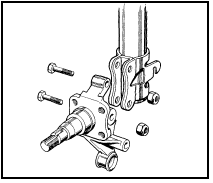Rear stub axle carrier Saloon and Estate models) - removal and refitting
Removal
1 Raise and support the rear of the car on
stands (see “Jacking and Vehicle Support”).
Remove the roadwheel.
2 Remove the rear hub as described in Section 9.
3 Remove the rear brake shoe assembly, as described in Chapter 9. You will also need to disconnect the brake fluid pipe at its connection to the wheel cylinder. Plug the pipe and cylinder connections to prevent fluid loss and the ingress of dirt.
4 Extract the handbrake cable through the backplate, then unscrew the four backplate retaining bolts and withdraw the backplate.
5 Position a jack under the lower arm and support it.
6 Undo the two nuts and remove the bolts securing the shock absorber to the stub axle carrier (see illustration).

16.6 Rear stub axle and shock absorber attachment - Saloon and Estate models
7 Undo the nut and remove the lower arm outboard pivot through-bolt.
8 Accurately record the location and number of washers at the tie-bar attachment then undo the nut and withdraw the stub axle carrier.
Refitting
9 If the stub axle is damaged or worn
excessively then it must be renewed.
10 Refitting is a reversal of the removal procedure, but note the following: a) When reassembling the tie-bar to the stub axle ensure that the spacers, washers and bushes are correctly located (as noted during removal).
b) Do not fully tighten the suspension retaining nuts and bolts to their specified torque settings until the vehicle is lowered and standing on its roadwheels.
c) Refit and connect the brake assembly components, as given in Chapter 9. Leave bleeding the hydraulic circuit until after the hub and brake drum are refitted.
d) Adjust the hub bearings, as detailed in Section 8.
See also:
Front suspension strut - removal, overhaul and refitting
Removal
1 Slacken the roadwheel bolts, raise the front
of the vehicle and support it securely on
stands (see “Jacking and Vehicle Support”),
then remove the roadwheel.
2 Support the underside of ...
Throttle cable - removal, refitting and adjustment
Removal
1 Disconnect the battery negative lead.
2 Working inside the vehicle, remove the
lower facia panel from the driver’s side.
3 Prise off the securing clip and disconnect
the end of the thro ...
Door trim panel - removal and refitting
Pre-1986 models
Removal
1 On Ghia versions only, remove the panel
capping by carefully prising out the retaining
clips using a forked tool. This can easily be
made from a piece of scrap metal.
2 ...
